Notes From FINA: 2018 World Water Polo Conference in Budapest
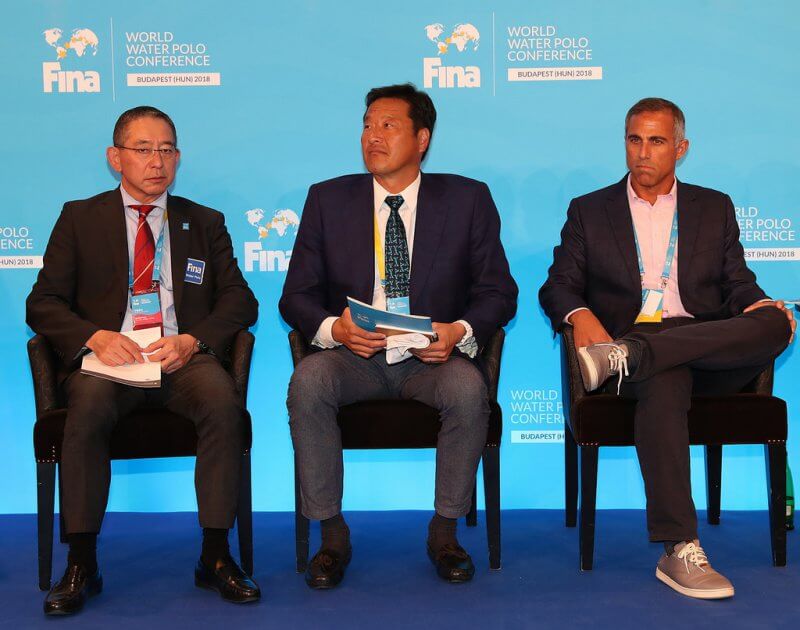
By Michael Randazzo, Swimming World Contributor
Over the past decade, FINA, the governing body for aquatics throughout the world, has regularly gathered water polo coaches, referees, administrators and other experts to take the temperature of water polo. Beginning yesterday in Hungary, representatives from over 100 countries gathered to debate the health and viability of the oldest Olympic team sport and—perhaps—suggest constructive changes that will propel water polo into a new era of prosperity.
“To advance water polo by inspiring visionary thinking and innovation”
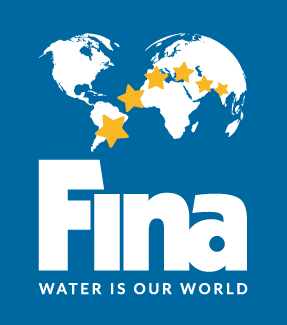
Conferences have been a regular staple of FINA conversations about the sport since the first one—titled: “FINA World Aquatics Convention”—took place in 2010 in Punta del Este, Uruguay. The most recent conference of this magnitude took place in 2014, when delegates convened in Cancun, Mexico. With 224 delegates in attendance at Budapest’s InterContinental Hotel, this is the first large scale meeting since FINA’s Technical Water Polo Committee met last July, also in Budapest, and approved controversial changes to Olympic play. In adding two more women’s teams to create a 10-team draw at the 2020 Tokyo Olympics and reducing the number of rosters per team to 11, the TWPC made sensible structural changes but also raised concerns of polo’s long-term viability as an Olympic sport.
Given this backdrop, there was heightened anticipation in Budapest that substantive discussions and presentations will spark necessary change for a sport that in the past ten years has faced multiple internal and external challenges.
What’s a reasonable expectation of progress?
In this spirit, it’s perhaps instructive to recall hopes for the 2014 convention. Slobodan Nikic, a Serbian water polo great, said at the time about expectations for the Cancun summit: “I have the feeling that this conference is a decisive opportunity for our beloved sport. We need to discuss and exchange new ideas, and to implement new models for the future.”
Francesco Grillone, an Italian who has covered water polo for decades, most recently from his platform as editor of waterpoloitaly.com, was biting in his commentary about Thursday’s proceedings. His most recent blog post described the gathering as a “joke” while taking aim at Cornel Marculescu, FINA’s Executive Director.
“Four years ago in Cancun itself history: projects requested by the almighty Marculescu, then always and only buried,” Grillone wrote in Italian. “Today same fate: in Budapest today and tomorrow there are three hundred people from the most disparate parts of the world who talk about water polo.
“We, save those twenty technicians [and] insiders who know what they are talking about,” opines Grillone, then suggested the conference’s main purpose is pleasure: “Here are the others on holiday award.”
Fact and fantasy collide on Day One
The program for Thursday was weighted with a number of critical tasks, including setting a tone for the delegates regarding what level of discourse might be expected. Setting a tone of urgency, Yiannis Gianouris, a one-time coach and now historian of the game, opened with a lesson regarding the evolution of water polo rules. Focusing on 1892, when the English—who invented the game 150 years ago—produced a standardized set of rules that all participating nations agreed to adhere to, Gianouris emphasized that the solution to many current ills can be rectified by re-examining polo’s founding principles.
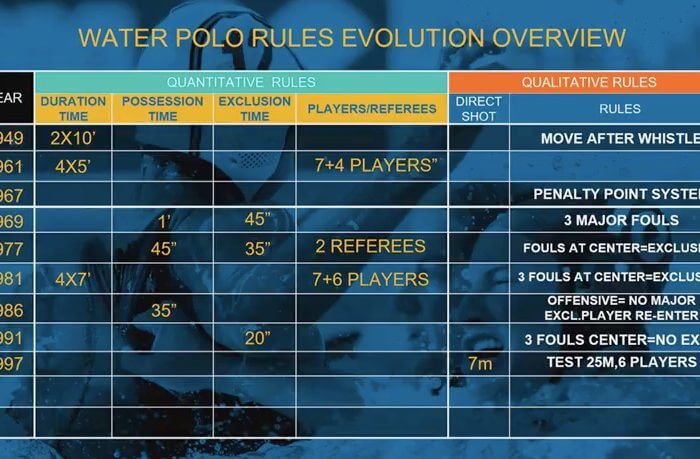
Photo Courtesy: FINA
A key point that Gianouris stressed at another panel—a discussion of water polo rules—is that, unlike other sports, there’s no definition in the polo rule books for an ordinary foul. Meaning that polo referees do not have a written framework for the most common of contact.
Gianouris urged delegates to go back to the past before going forward.
Perhaps the day’s most potent arguments were presented by Dragan Jovanovic. A former player for Yugoslavia whose impact on the sport is derived from his work coaching the Canadian National Team (2004 – 2012) and now as Director of HaBa WaBa North America, Jovanovic is also Director General for the World Water Polo Coaches Association (WWPCA). One of the more influential bodies in the sport, the WWPCA—consisting of top coaches including Croatia’s Ratko Rudic—a four-time gold medal winner as a coach—Italy’s Alessandro Campagna, Serbia’s Dejan Udovicic, America’s Adam Wright, Hungary’s Balazs Vincze and Spain’s Quim Colet—immediately responded to the much-criticized rule changes FINA announced in July 2018.
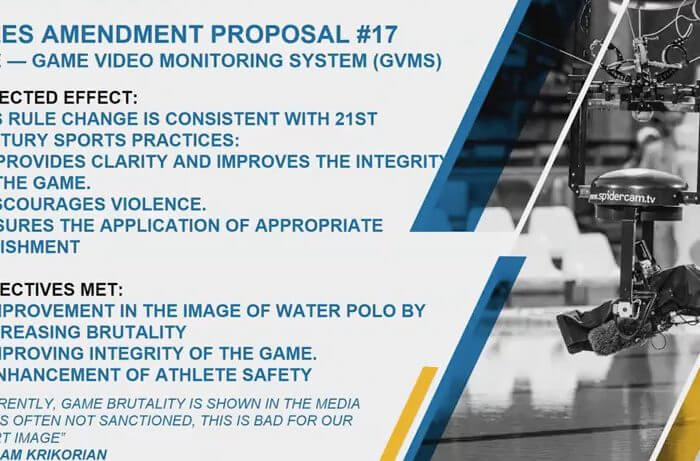
Photo Courtesy: FINA
A participant on multiple panels—Water Polo Reform 21, described as “unprecedented measures to ensure the widest possible coverage of opinions in the history of our sport and participation of all stakeholders of Water Polo,” and Water Polo Rules— Jovanovic’s presentations could have been a conference all by themselves. A series of ideas both practical and far-fetched—for the staid water polo establishment—advancement, the one-time goalie towered over the delegates while regaling them with a dizzying array of possibilities.
Jovanovic did focus on practical matters; according to his research, 70 – 80% of the current international game is consumed either with center play or maneuvering for a 5M or longer shot off of an ordinary foul. He urged that, in an age of cellphones and social media where spectators can post controversial calls, video review of all goals is essential. An idea to impose time constraints for the hole set in the crease reflects polo’s similarities to basketball, which in 1936 imposed a three-second restriction in the front of the basket.
Not fully vetted due to time constraints, the suggestions of the collected WWPCA wisdom offered tantalizing hope for tremendous innovation in a game that—as Gianouris had deftly pointed out earlier—is in need of strategic renewal and investment for the future.
“Insufficient investment,” Jovanovic remarked about a consistent concern about polo’s future. “There’s no successful business in the world without proper investment.”
Referees, coaches and even players have their say
For a conference intended as an examination of the underlying structures of the sport, referees received relatively little attention. Mark Koganov, Vice Chairman of FINA’s Technical Water Polo Committee, joked about the conference logo (a referee’s whistle) then made a point about how under-paid—and in certain cases, underappreciated—the game’s chief gate-keepers are.
“What kind of professionalism can we expect from volunteers who are judging professionals with lucrative contracts,” Koganov said.
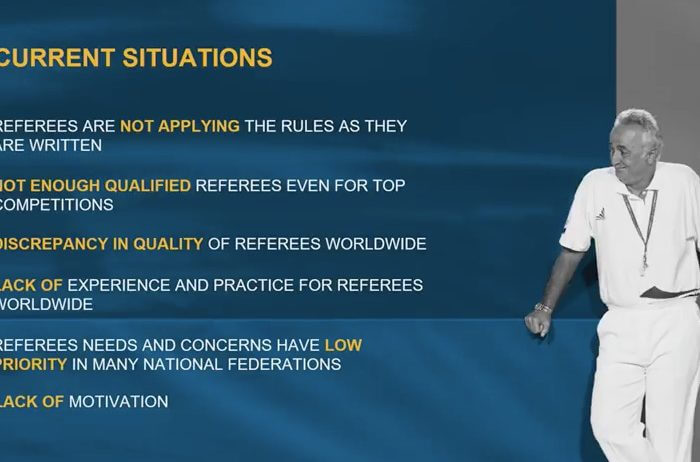
Photo Courtesy: FINA
He concluded with a plea for technology funding to create a reliable database of FINA referees. Clearly a pressing need, but not as crucial as another key observation by Koganov; there’s simply not enough qualified referees available to cover all the high-level play that currently exists.
Danny Kurmann, a long-time official for the International Ice Hockey Federation (IIHF), provided interesting comparisons and contrast between water polo and hockey officiating. With examples of the decisive impact of technology on game play Kurmann—perhaps inadvertently—reinforced Jovanovic’s earlier point about the polo’s need for video review.
Once the referees had their moment, a panel of coaches settled in to compliment and counter what their pool deck counterparts said. Adam Krikorian, whose success with the U.S. women’s team provides him the levity to say what he really thinks, revealed that his game-prep changes from tournament to tournament because of vast differences in officiating. Dénes Kemény, the legendary Hungary coach, echoed his American coaching comrade by arguing that application of the rules are what varies most during play, and that’s what makes coaching in polo a minute-by minute affair.
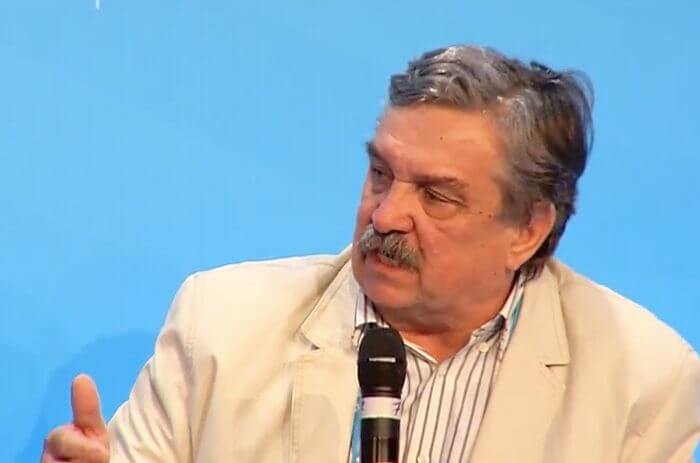
Ratko Rudic. Photo Courtesy: FINA
In a blunt expression of how coaches see rules and rule makers, Ratko Rudic said that his approach was to interpret them in any way that allowed his team the best chance at success. Never one to be suspected of affection for the men in white, Rudic is remembered for a tirade following a 2000 Olympic quarterfinal loss to Hungary by his Italian team—where the fiery coach accused the refs of a conspiracy against his team—that resulted in a year-long suspension.
Perhaps the most day’s honest assessment came from Japanese men’s head coach Yoji Omoto. Speaking through a translator, the professorial Omoto presented the reality that many left unsaid: an approach to the game focused primarily on massive bodies receiving the ball dead center of the goal has little future if the game is to grow. Specifying that the average height of a Japanese male is 1.78M (5-10)—dwarfed by the 2M giants that populate the Serbian, Croatian and Montenegro rosters—Omoto stressed that his teachings to his players are to “cut the supply line to the center” and focus on the horizontal, or speed game.
He also pointed out that—given current rules—he would not allow his three daughters to play polo, a perhaps damning, if understated, indictment of the game.
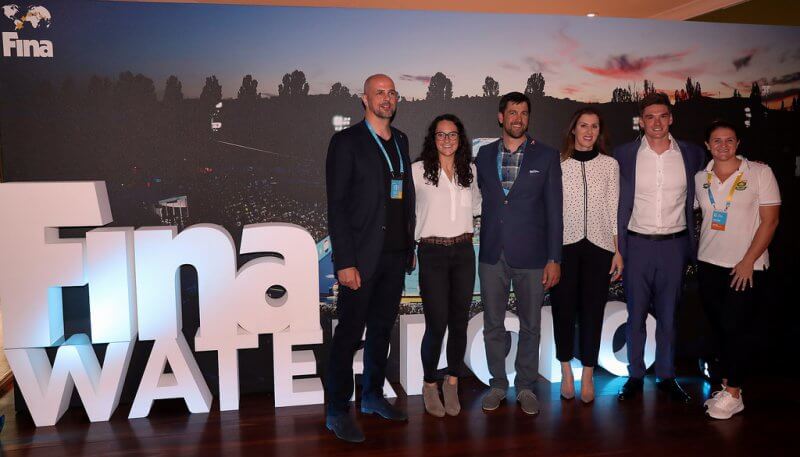
Players assemble in Budapest. Photo Courtesy: FINA
In an effort to provide a full picture of the sport, and to close the first day’s proceedings on a congenial note, FINA invited actual water polo practitioners on to the dais. Maggie Steffens of the U.S., Canada’s Aaron Feltham, Aaron Younger of Australia, South Africa’s Kelsey White and Istvan Gergely of Hungary answered questions designed to be as comfortable as possible.
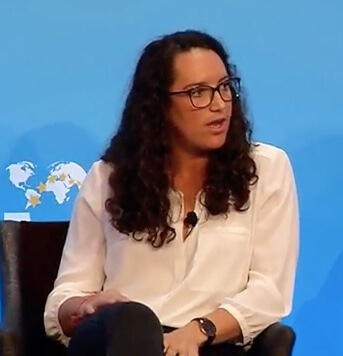
Maggie Steffens. Photo Courtesy: FINA
For a sport that has perhaps unfairly been stigmatized for its violent collisions and under-water antics, Steffens—who with double Olympic titles (2012 and 2016) and three U.S. college championships may be as close to a “Golden Girl” as exists in polo—waxed poetically about an unexpected opportunity to play beach polo and a spontaneous joy for a sport that she’s spent the majority of her life pursuing to perfection.
After a full day’s focus on sport’s challenges, it’s perhaps the delight that its players derive from a brilliant athletic spectacle that seamlessly combines water, light, color and sound—and their unbridled joy of competition—that best points the way forward for polo.



